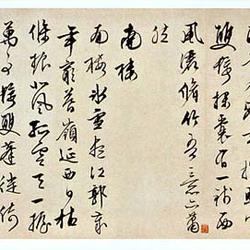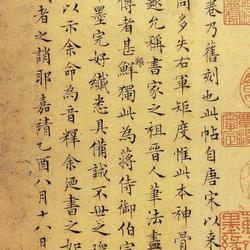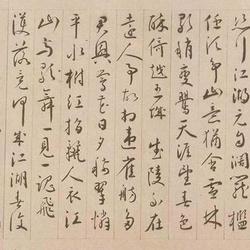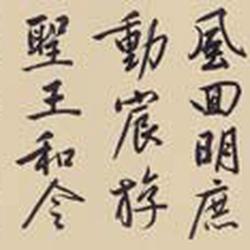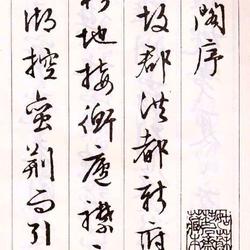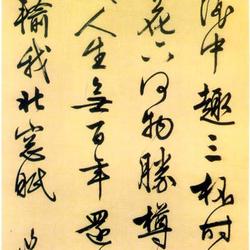


Part of "Xiyuan Poems" (1554), paper, cursive script, length 28.4 cm, width 447.4 cm, collected by the Palace Museum, Beijing
This is one of Wen Zhengming's representative works of cursive script. Wen Zhengming (1470~1559), whose original name was Bi and whose courtesy name was Zhengming, was later changed to Zhengzhong and his nickname was Hengshan Jushi. A native of Changzhou (now Suzhou, Jiangsu). At the age of 54, he was recommended as a tribute student to the Ministry of Civil Affairs and was appointed to the Hanlin Academy to await an imperial edict. The original is Tibetan scripture paper with black silk railing, 28.4 cm in length and 447.4 cm in width. "Poetry of the Western Garden" was written by Wen Zhengming when he was 56 years old in Beijing and was waiting for an imperial edict. It consists of 10 poems in seven rhymes. It describes the scenery of the Imperial Garden (today's Zhongnanhai and Beihai) centered on Taiye Pond in the west of the palace city. This volume was written in Jiajingjia On June 10th of Yin (1554), 30 years after he wrote the poem, Wen Zhengming was 85 years old. The cursive writing in this volume is vigorous and smooth, and the style is neat and elegant. It is one of his masterpieces in his later years. There is a Qing Dynasty at the end of the volume. Wang Shu's inscription and postscript, as well as "Qingdi Appreciation of Calligraphy and Painting Seal" and many other seals. It is now in the Palace Museum.
Explanation:
Ten poems from Xiyuan
Long live mountain is located in the northeast of Zicheng and is the town's main mountain. The trees above it are shaded, and there are many precious fruits, so it is called Baiguoyuan.
The sun rises, the flowers and mist in Lingshan disappear,...
Taiye Pond is located outside Qianming Gate in the west of Zicheng, several miles away from Fanfan. It is surrounded by trees and spanned by stone beams, with Qionghua Island in it.
The Yangzhao Cangchi is too clear, and the hibiscus is ten miles flat.
I once heard the Yuefu song about yellow swans, and saw the autumn wind moving stone whales.
The jade trees are curled up and falling in the blue, and the silver mountains are misty across the world.
I know that when the phoenix chariot passes by, I won't be surprised when the geese come back to fly.
Qionghua Island is located in Taiye Pool. It is said that the Shangguang (missing the word "Han") Palace was the place where the Empress Dowager of the Liao Dynasty rested. …
Chengguang Hall is located on Taiye Pond, surrounded by an urn city. The structure of the hall is like a cover, which is called a round hall. It is very strange to find an ancient tree in it. …
Longzhoupu is located in the northeast of Qionghua Island...
The banana garden is on the east bank of Taiye Lake...
There is a stone pool in Lecheng Hall in the Bajiao Garden. There are three pavilions in the pool. Zhu beams are used to connect the pavilions. There are nine hills on the left and right, which are called nine islands. In the other hall, a stream was dug, the water was stirred up to turn the tiller, and the grain from the south field was grinded to make it. It was pounded and cured here, so it was called Lecheng.
…
Nantai is located in the south of Taiye, with Zhaohe Hall on the top and Shuitian Village on the bottom. Yu Xianchao tasted the harvest here.
Qinglin's meandering ladies turned back to the pond and went south to the high platform to face the garden wall.
The warm sun signals that spring is about to move, and the wind in the palace makes it cool during the day.
Don't open the waterside pavilion and see the rainbirds. Down below, you can see the ripe rice in the flat fields.
When the emperor traveled to Henan, he actually banned Jiangxiang.
The Rabbit Garden is located to the west of Taiye Pond. It is surrounded by mountains and temples, covered by trees, and looks like a pond at the foot of the mountain. Dragons stir in the water, and dragon kisses appear in the ground.
The king of Han Dynasty left the palace while he was away from home, and there were many people walking around Suo Chao and Zhu Fei.
The spring breeze in the other hall is filled with purple phoenixes, and the hills are flying over the streams with clear rainbows.
Tuan Gong Zhi covers the sky and the forest looks out, and the dragon spring sprays and turns.
Simplicity originates from the events of Yao and Shun, so Yingliang Garden is different.
The platform is in the north of the Rabbit Garden, with Taiye in the east and Taiye in the west. Under the garden wall is a galloping path where horses can walk. Emperor Wu used to read and shoot here.
The palace walls are covered in purple as the sun rises, and the former emperor has a stage for his martial arts parade.
The galloping road below ends near the city, and the flying pavilion in the east reflects the water.
The clouds are always sparse and scattered, and the birds spy on the fairy sticks as they go and come back.
Jinhua's hair turned white when he received the imperial edict, and Yang Gui was ashamed of his talent if he wanted to give him a talent.
The poem on the right was written in the spring of Yiyou, Jiajing, on the 10th day of the sixth month of Jiayin, so it was thirty years old, and the remaining years were eighty and five years old, a sign of clear knowledge.
Later, Wang Shu wrote a postscript and a brief summary of the text.

